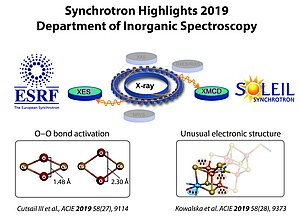The research in the Department of Inorganic Spectroscopy, led by Prof. Serena DeBeer, focuses on the development and application of advanced spectroscopic techniques to understand catalytic reactions. A strong focus lies in understanding the chemistry of breaking and forming chemical bonds by biological catalysts. Here, two particular reactions are of great interest, namely the biological dinitrogen reduction and dioxygen bond activation. In Nature, these processes are, respectively realized via nitrogenase enzymes or copper proteins (such as hemocyanin and tyrosinase).
In order to understand how these systems, cleave the strong N-N or O-O bonds, one needs to understand their structure, including very characteristic and sometimes also unusual electronic structures of the metals from which they are comprised. In such research, not only intact proteins are being investigated, but also molecular model complexes that mimic different possible motifs of the protein active sites. Further, there is a strong motivation to study both the enzymes and molecular models by spectroscopic approaches and to develop novel approaches to understand their mechanism of action.
This definitely lies in the expertise of the Department of Inorganic Spectroscopy and was demonstrated last year in two papers, both published in Angewandte Chemie International Edition as “Hot Papers”. We reported about these findings in our Website News 4/2019 and 7/2019. These results were now additionally recognized in the Highlights Reports 2019 of the European Synchrotron Radiation Facility (page 107) and SOLEIL Synchrotron (page 34). Most of the 50 synchrotron and free electron laser light sources worldwide select annually the most interesting and important results coming from research performed using their facilities and include them in annual reports. Both Dr. George Cutsail III and Dr. Joanna Kowalska, former postdoctoral researches in Prof. DeBeer’s group are very pleased with the recognition and happy that their research will now also reach not only scientists from other disciplines but also a broad general audience.

